Oct 2023
If you find this read interesting, share it on:
Continuing our discussion on Bhagavad Gita we move on to Chapter 3 – In the previous chapters Krishna had taught Arjuna that one should be centred or maintain equanimity in pleasant and unpleasant situations. But Arjuna had not internalised and assimilated the teachings yet, he was yet not convinced why he should fight the war.
Thus, Shri Krishna goes on to explain that it is the tendency of nature or “prakriti” to act continuously. Now let’s shift our attention to the human body. It too, is constructed by nature, wouldn’t it also follow the tendency of nature towards continuous action? Even if we somehow manage to physically sit still, our minds will be racing with thoughts. And even the act of thinking is an action. So, what’s the conclusion? We have to find a way to eliminate vasanaas (attachments/hopes) while we are performing actions. That technique is Karma Yoga.
Having covered the topic of why one should perform action, Shri Krishna then speaks about what kind of action should be performed. He urges Arjuna to only perform “niyatam” or prescribed actions, we can interpret this as one’s duties but without any trace of attachment to the action or to the fruit.
Shri Krishna also assured Arjuna that it was perfectly possible to attain the ultimate goal of realisation yet be working in this world.
The beauty of the Gita’s teaching is that it takes care of every person. There is no fixed rigid path – each one arrives at their path through self-analysis. It is like a kitchen where each spice is unique but has a distinct role to play in making a meal.
Leading to our discussion of the markets , where we did address the point on valuations in our August, 2023 Newsletter and analysed the 1QFY24 earnings in our September, 2023 Newsletter. In this month's edition we also see how India has strengthened on some of the structural factors which makes us believe that for India all seems to be falling in place.
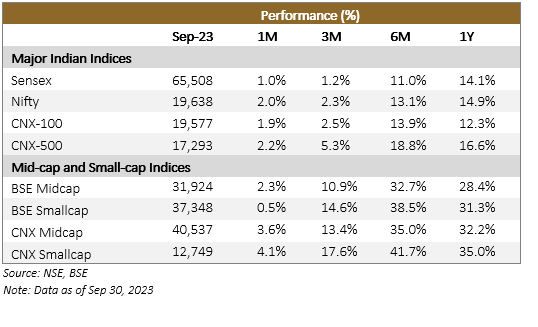
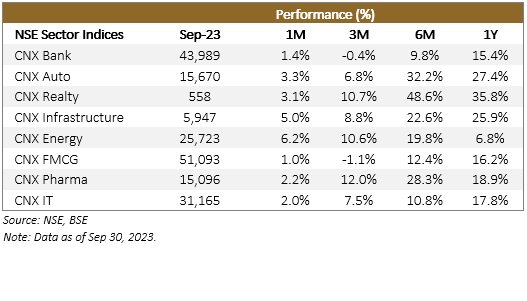
Here are Some Structural Changes Helping the Indian Economy
Respect for the Girl Child
According to the National Family Health Survey (NFHS) conducted in 2019-21, the sex ratio of the total population (females per 1000 males) has improved to almost 1020 vs 991 in NFHS conducted in 2015-16. According to the United Nations Population Fund, India had one of the lowest sex ratios in the world back in 2015. The improvement in the sex ratio at birth in India is a positive development that is a result of the various government initiatives and laws aimed at addressing the issue. However, there is still much work to be done to ensure gender equality and eradicate discrimination against girls and women. In conclusion, the sex ratio at birth (for children born in the last 5 years) in India has begun to normalize.
What this means is that India clearly is going through a social transformation, there is a dramatic decline in female foeticide and more women are going to school, more females are using the internet on their smartphones, and we will have a stronger female base adding to the incremental world working population from India and more domestic consumption.
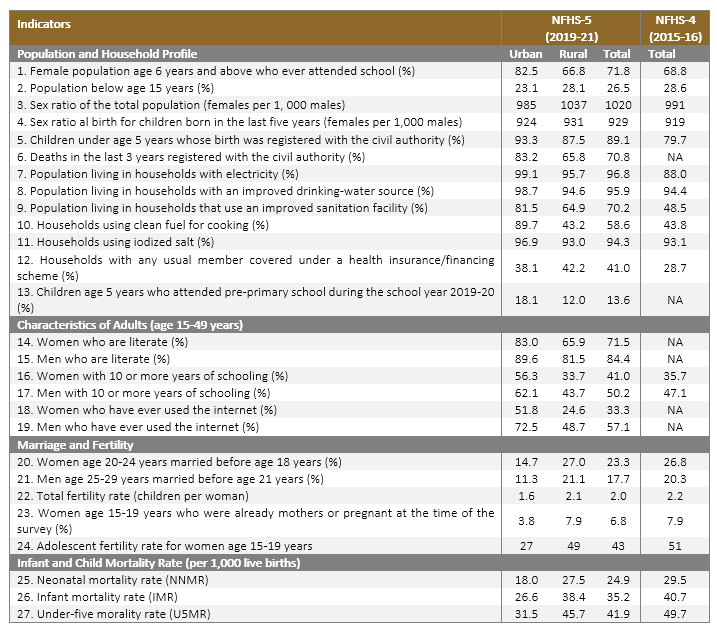
Source: mohfw.gov.in
Direct Benefit Transfers
The DBT (Direct Benefit Transfer) Scheme that was launched in 2014 has already transferred almost USD ~400 bn (INR 32,29,162 Cr) Source: dbtbharat.gov.in so far with the help of Aadhar Linked Bank accounts it was made foolproof that the benefits going to the poor shall in-fact go to them and not to some middlemen.
Internet Connectivity
About 2.5 lakh villages have been connected with Fibre Optic Links and nearly 1.2 mobile sets are there in India and about 800 million are using the internet, with India having one of the lowest Internet rates in the world.
Average Revenue Per User (ARPU)/Data rates ($/GB)
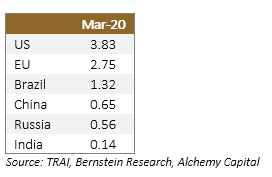
This should aid rapid digitalisation.
Digitalisation
Through a series of nimble innovations, NPCI – (National Payments Corporation of India) has digitised and revolutionised the Indian payments space. Being a non-profit organisation, NPCI is likely to invest all the profits (profit margins close to 45%) to build more products and add more features. NPCI’s most successful product platform remains UPI, which is expected to surpass Mastercard's daily transaction volume of 440 million. Visa, amongst the world's largest card network, processes an average of 750 million transactions per day. Source: moneycontrol.com
It has also created an ecosystem for fintech players to offer products on top of the platform and created multi-billion-dollar private enterprises/startups.

Some of these factors are leading to improving per capita GDP in India aiding premiumisation.
GST Collections are Improving.
With increasing digitalisation, GST collections are also improving in India. For example, for FY24 the government has collected GST of INR 9.9 t in 1HFY24 (vs. INR 8.9 t in 1HFY23). It means that GST collections have averaged INR 1.63 t per month in 1HFY24, compared to the budgeted estimate of INR 1.59 t per month. With this run rate, there could be an excess collection of about INR 700 bn in FY24, unless we see a slowdown in 4QFY24.
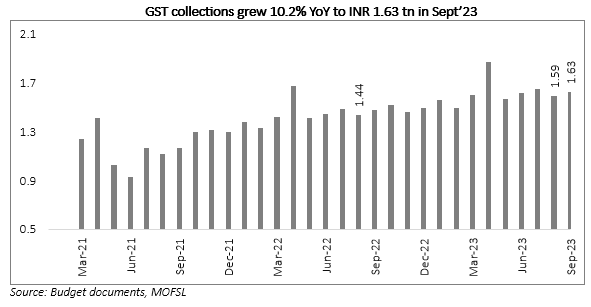

GDP growth trend comparison- India vs Other Emerging and Developing Economies, India Seems way ahead of most other economies.

Gross Fixed Capital Formation ("GFCF"), which is a measure of the net increase in physical assets, witnessed an improvement in Fiscal 2022. As a proportion of GDP, it is estimated to be at 32.7%, which is the second highest level in seven years (since Fiscal 2015). In Fiscal 2023, the ratio of investment (GFCE) to GDP inched up to its highest in the last decade at 34% as per the advanced estimate released by the Ministry of Statistics and Programme Implementation ("MOSPI").


The share of manufacturing is poised to grow driven by production linked incentive schemes across 14+ sectors including pharmaceuticals, textiles, medical devices, auto components, and white goods (electronic items such as refrigerators and television) among others.
Exports
Between the liberalisation of 1991 and 2022, India's total exports rose at a CAGR of 11.8%, while services exports rose at a CAGR of 14.2%. At the same time, while the merchandise trade deficit has gone from USD 5.5 bn in 1991 to almost USD 272 bn in 2022, the services sector has seen a trade surplus, from a meagre USD 1 bn in 1991 to USD 128 bn as of 2022. Hence, it is no surprise that the share of services in India's total exports has been constantly increasing since 1991 making up almost half of India's total basket.

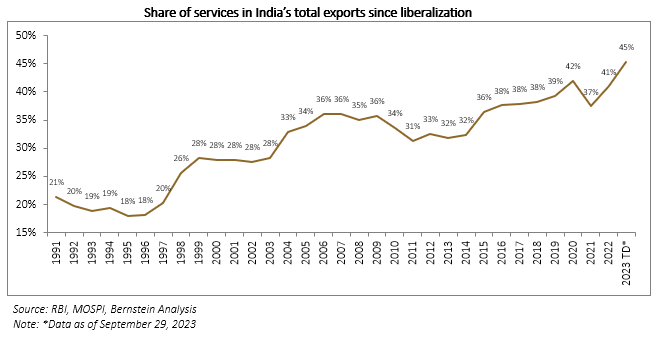
Given that India is expected to add 22% of the world's working-age population by 2031 (based on Morgan Stanley estimates as below), we think the services share can only continue to move up.
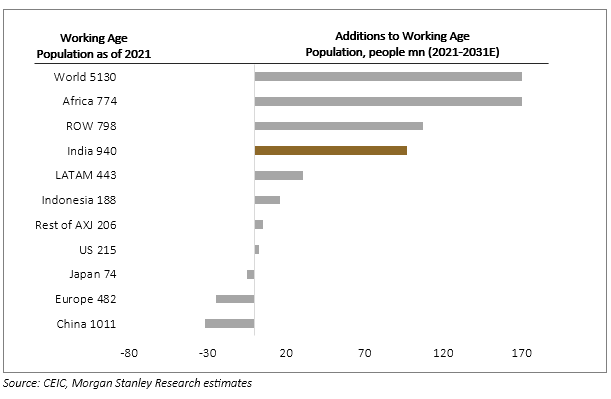
We conclude here with our thoughts that FOR INDIA ALL SEEMS TO BE FALLING IN PLACE
Getting back to our Bhagavad Gita discussion another point in Chapter 3 is that Karma Yoga should not be restricted to only a few aspects of life. The Karma Yoga mindset should eventually become second nature, in other words, it should be embedded in each and every action that we perform, from writing an email to eating our meals, we should remember to derive joy from the action itself rather than from the result. Only then will we begin to drop attachment to the action and the result. The best example here would be our mothers who always cook what her family members like and put her preferences on a lower priority and do the action only out of love expecting nothing in return.
Shri Krishna concludes the chapter on Karma Yoga with a profound message: strengthen oneself by oneself.
Disclaimer: Investments are subject to market risks, please read all product /strategy related documents carefully before investing.
Himani Shah
SVP – Investments & Research
Alchemy Capital Management Pvt. Ltd.